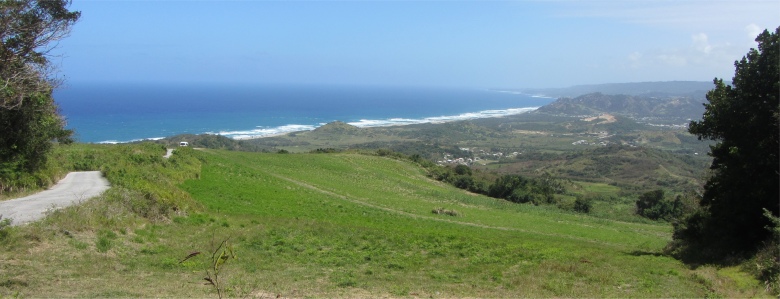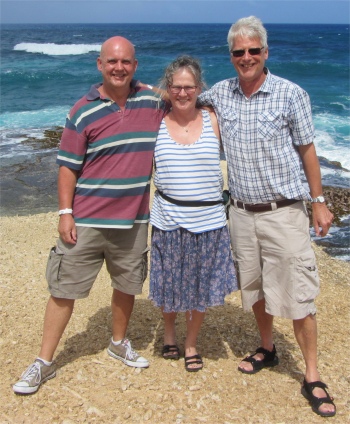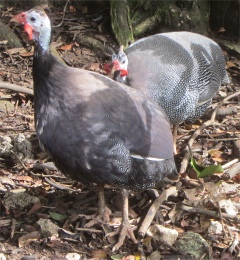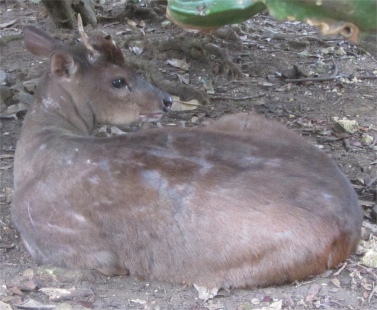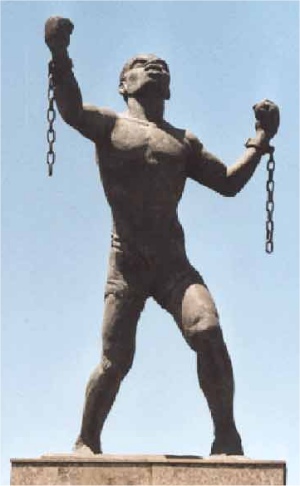The expanse of sand was almost deserted. An old Bajan chap was ambling in the surf along the beach, slowly dancing with his hands in the air, rocking to the rhythm of the surf rolling in. At times he seemed to be conducting the waves as they washed around his feet. He would catch up with what appeared to be an oversize basketball, which he then picked up and heaved another 10m along the surf. Then followed another dance routine till he caught up with the ball again, which of course he heaved again. On reaching the rocks at the end of the beach he would simply turn around and come back again. Perhaps I should give it a try sometime.
A large, stout , British chap was content to walk up and down the beach too, exchanging pleasantries as he passed.
The early morning sea was deliciously cool, and I was aware of shoals of small fish as I swam out to one of the breakwaters, the water rapidly becoming deeper as I approached these man-made beach protectors.
After a while a few couples appeared on the beach enjoying their early morning strolls, and a couple of chaps who took to the waters too. Crumbs, it must have been rush-hour.
Then I caught sight of something out of the corner of my eye, and spotted a small land crab cower down into a footprint I had left in the sand. I crept up to investigate him, and he quickly scurried off with one of his claws defiantly waving a piece of bread in the air. The approaching surf picked him up and he somersaulted around in the swirling water before a larger wave deposited him ashore. He then seemed to hover in mid-air as he rapidly sped off on a blur of thrashing spindly legs; amazing to watch, not unlike a drone anchored to the earth.
I lazily watched the first plane of the day glide in, and then returned for a shower and breakfast - a delightful way to start the day. As I passed the neighbour's trash bins, the ones that had been emitting a terrible stench, I found that the one that had contained all the flies was now awash with maggots, all crawling in a clockwise direction along the bottom 30cm of the inner surface of the bin. Argh ...! They will soon turns into flies and invade Mike's bungalow. I returned in a few minutes with boiling water and bleach to foil their plan.
Over coffee, Rex gave me a wonderful account of the Elite Racing Club. For a fee he receives a weekly newsletter which provides him with inside information from the stables on how each of the Club's horses in training are progressing at home, in readiness for a racecourse appearance. The Club maintains an average of 25 horses across the training and breeding regimes, but members are not acquiring any of the bloodstock equity and therefore there are no ongoing costs for training fees or vet bills. He also has a chance to spend time with a trainer at the gallops, where he and about 30 more members can see and hear first-hand how the horses are performing, and the progress of the stud programme. Rex is well hooked into the Club, as is Meryl who enjoys horses and often goes out on local hacks in the U.K. Now how did Rex only pick one winner at the Gold Cup Races?
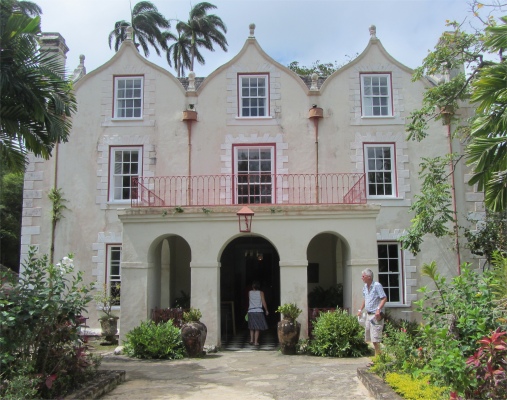 Great House of St. Nicholas Abbey |
Our destination was St. Nicholas Abbey. Built in 1658 by Colonel Benjamin Berringer, St. Nicholas Abbey is one of the island's oldest surviving plantations. With its original boundaries still intact, the plantation is located in the hills of St. Peter, encompassing over 400 acres of undulating sugar cane fields, lush tropical gullies, mahogany forests and formal gardens. Despite its name, there is no religious connection here at all. The name is credited to the 19th century owners, Charles and Sarah Cave, who combined "Nicholas Plantation", "St. Nicholas Parish" near Bristol where Sarah's family lived, and "Bath Abbey" nearby where they were married.
Parking up among towering cabbage palms, we entered the site and immediately fell upon the plantation's Great House. Its stone-and-wood architecture makes it one of only three Jacobean-style houses still standing in the Western Hemisphere, the other two are Drax Hall, also in Barbados, and Bacon's Castle in Virginia, USA. The building had Dutch gables, coral stone finials, and four cornerstone chimneys. The Jacobean-style is a transitional phase in English design; it merged the Tudor and Elizabethan styles with continental Renaissance influences, including Flemish, Dutch and French architecture.
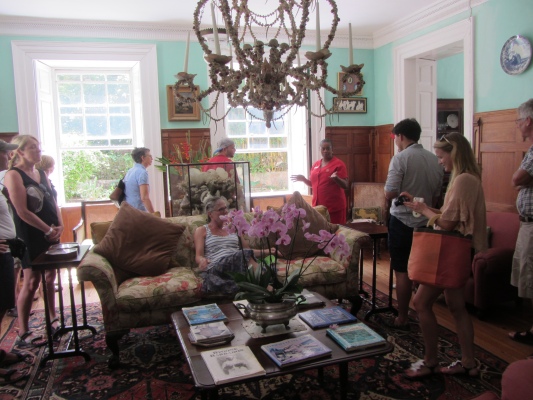 Drawing Room of the Great House, Meryl Taking a Seat |
Our tour began in the drawing room. Sir John Gay Alleyne added the Georgian-style triple arcaded portico and sash windows in 1746. The cedar panelling was installed in 1898 to protect the home from dampness, likely taken from trees that fell during the strong hurricane that hit the island that year. The mahogany door, added in 1910, was also felled on the planation.
The roofing beams, while not visible from the ground floor, are original to the home; however the original flooring was replaced with Honduras Pitch Pine, imported from North America, in 1910.
Many of the antiques date to the 1800s, including two Wedgewood tea sets. The Sailor's Valentine collection includes wonderful examples of these popular souvenirs of the period, often brought home for loved ones after a long voyage at sea. Featuring intricate designs created from local and imported seashells and other natural materials, the patterns typically centred on a compass, heart or sentimental message. The lady pointed out that although the name suggests the sailors made these valentines themselves, most originated in Barbados, a popular seaport of the era. The New Curiosity Shop, located in the island's main port by the old ice house in Bridgetown, sold most of the valentines produced by local craftspeople. Hmmm..... perhaps Rex may be encouraged to create one of these for next Valentine's Day.
 Dining Room of the Great House |
The study contained a Burlington Gentleman's Chair, manufactured in 1935 by Foot & Co. (a manufacturer of hospital equipment during WWI), defined modern relaxation of the time. Described in advertisements as the "ideal easy chair", it could be transformed into a semi or full length couch with the push of a few buttons. Featuring adjustable tables, a book holder, reading lamp, backrest and footrest, it was a common spot for impromptu napping. The chair could be easily wheeled into another room for the duration of the nap. There is also a Mahogany Judge's Chair featuring the Coat of Arms of William IV, made in England in the early 1830s.
A stunning set of Minton China (c. 1850) is located in the cabinet. Greatly influenced by French Sèvres Porcelain, English-made Minton China was very popular with 19th century embassies and heads of state. The collection of 19th century glassware decorated in gold leaf was a wedding gift from the Duchess of Buccleuch to Lt. Col. Cave's grandmother in 1895.
 Bathhouse and Outhouse |
"Unfortunately, the stairs are not safe, so we will have to forego a tour upstairs," our guide informed us. Instead she led us out into the courtyard behind the Great House. This stable yard is home to the 400 year old Sandbox Tree (Hura crepitans), an evergreen indigenous to the Caribbean. The woman told us that whenever she brought a group of school children into the courtyard, she always told them not to tap the tree with their hands. Amazingly, none of them did. However, adults always had to have a go, much to their regret. I inspected the tree closely to find a multitude of tiny, sharp spines that have given this indigenous evergreen the nickname "monkey-no-climb".
The bathhouse and outhouse stood to one side of the yard. The outhouse was once outfitted with a four-seated privy (a two-seated privy was employed at George Washington House), quite a strange concept by today's measure of privacy. There is also a water storage cistern connected to the well and reservoir located by the main entrance gate.
 "Annabelle" in the Distillery |
Over the next century, distillation practices significantly improved and Bajan rum became renowned in both Europe and Colonial America. Alcohol played a large role in 17th and 18th century life; it was drunk during social occasions, used medicinally and served as a valuable trading commodity.
A young fellow gave an account of sorts about the rum distilled here, but sadly the lad's speech impediment rendered his talk almost unintelligible to me. He had three bottles of rum in front of him on a table: 3-year-old, 12-year-old and 18-year-old, plus a large tray of glasses. He gave each couple a small tot of the 3-year-old rum to share. I seemed to confuse him somewhat since I was a singleton, but I convinced him to give me a tot. That went down well, it had been a long time since I drank a straight rum. Then we proceeded to sample the 12-year-old rum. This was definitely a lot smoother than the 3-year-old. "If you want to try the 18-year-old rum, one of you will have to buy a bottle and share it out amongst yourselves," laughed the chap.
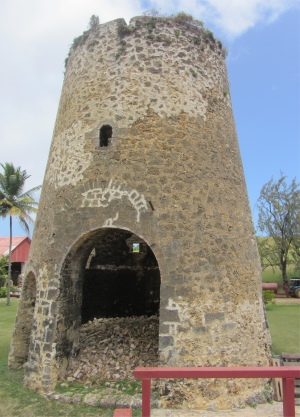 Plantation Old Windmill |
 Boiler House |
There are infinite possibilities for rum since its taste and aroma are derived from the source of sugar (typically molasses, or cane juice), the fermentation process, type of distillation, and finally aging, all of which contribute to the final outcome. Uniquely, St. Nicholas Abbey Rum is the only rum produced in Barbados from cane syrup (rather than molasses), following the traditional molasses distillation process. The syrup is stored to ensure year-round production since the Bajan crop season runs only from January to June.
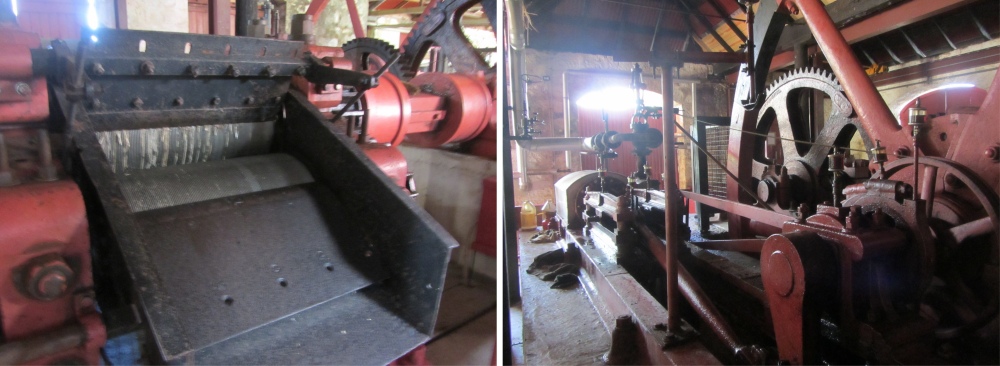 Cane Crushing Plant |
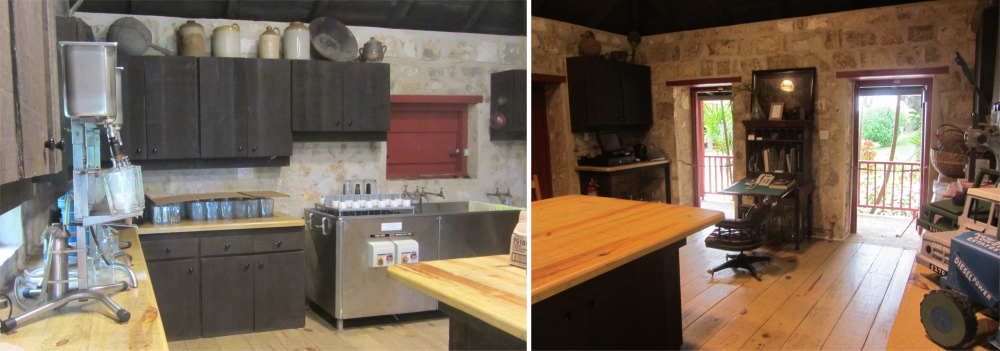 Bottling Room |


